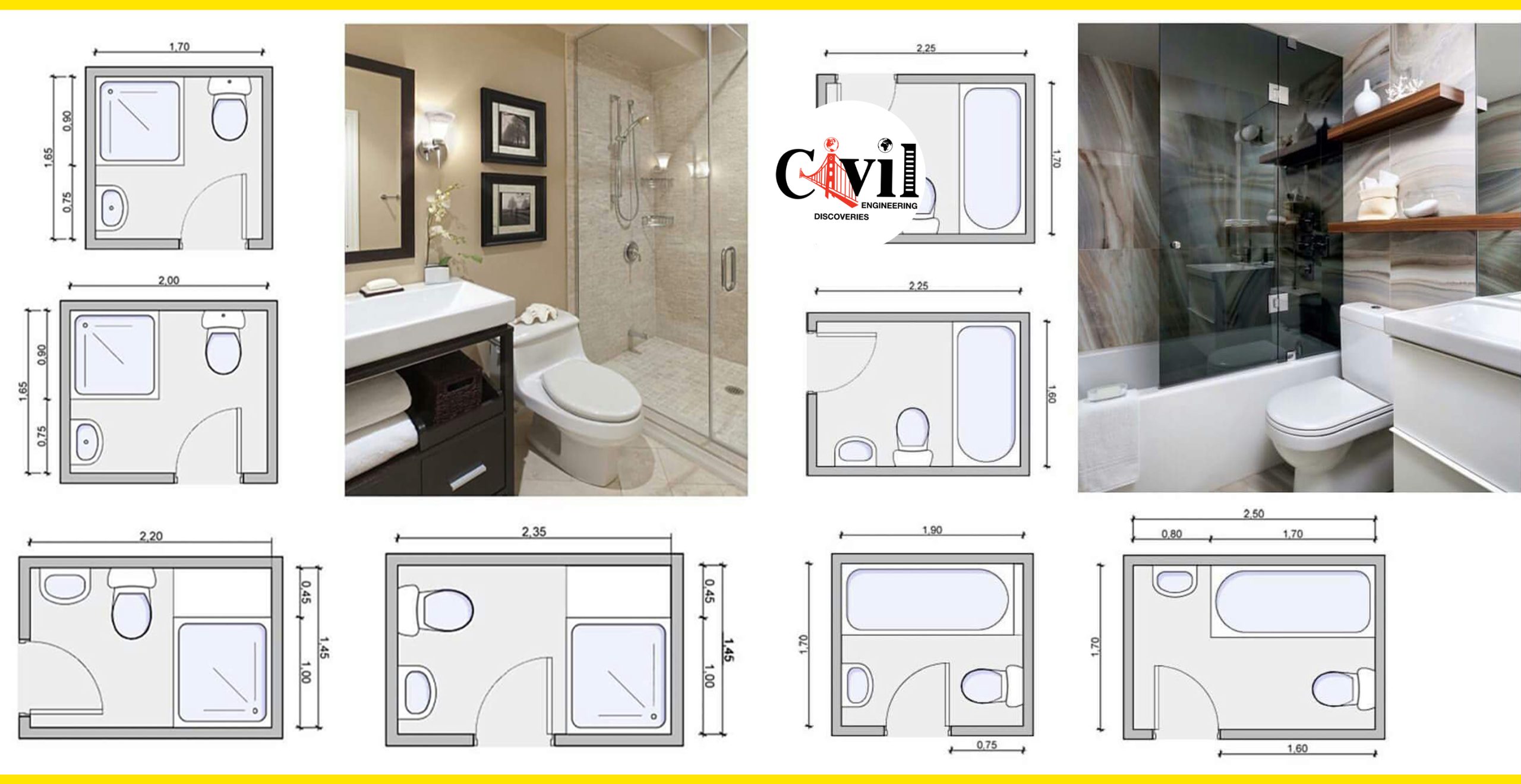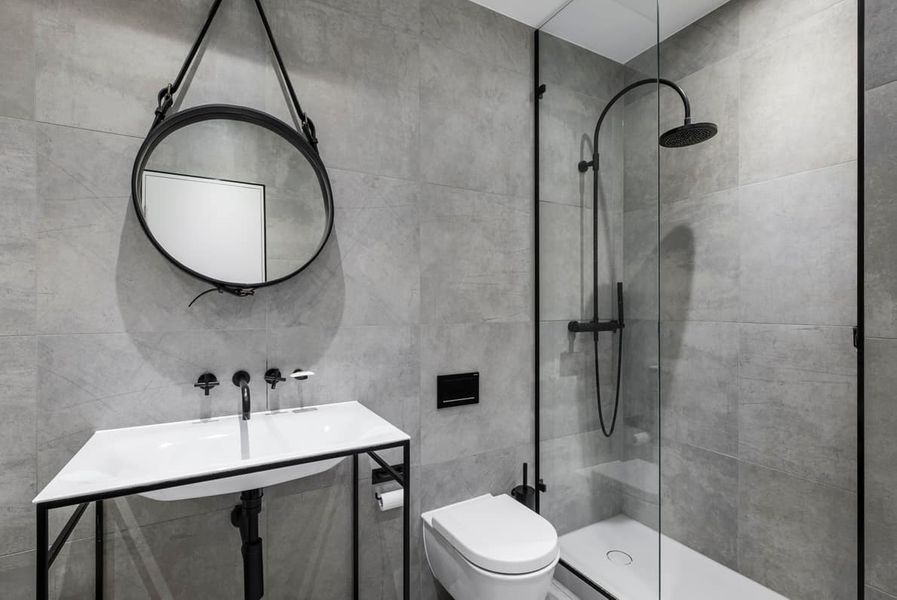ADA Bathroom Design Principles

The Americans with Disabilities Act (ADA) establishes guidelines for accessible design, ensuring individuals with disabilities can use and enjoy public and commercial spaces. This includes bathroom facilities, where accessibility features are crucial for safe and independent use.
Shower Accessibility Features
ADA compliance in bathrooms requires specific design elements to accommodate users with varying physical abilities. These features aim to provide safe and comfortable access, including:
- Clear Floor Space: The ADA mandates a minimum of 30 inches by 60 inches of clear floor space in front of the shower, allowing users to maneuver safely and comfortably. This area should be free of obstructions, ensuring sufficient room for wheelchairs or mobility aids.
- Grab Bars: Grab bars are essential safety features, providing support and stability for users entering, exiting, and using the shower. ADA regulations specify the size, location, and strength of grab bars, ensuring they can withstand significant weight. They are typically placed near the shower entrance, on the wall opposite the showerhead, and in the shower stall.
- Accessible Shower Controls: Shower controls, including faucets and temperature adjustment knobs, must be positioned within reach of individuals using wheelchairs or seated on a bench. These controls should be easy to operate, with clear markings and tactile indicators to aid in identification.
Importance of Clear Floor Space, Ada bathroom with shower
Clear floor space in the shower area is crucial for accessibility, allowing users with mobility impairments to move safely and independently. This space should be free of obstructions, such as furniture, fixtures, or protruding objects, ensuring adequate room for wheelchairs, walkers, or other mobility aids to maneuver.
- Maneuvering Space: A minimum of 30 inches by 60 inches of clear floor space is required in front of the shower, allowing individuals in wheelchairs to turn and position themselves comfortably.
- Transfer Safety: Adequate clear floor space enables users to safely transfer from their wheelchair to a shower seat or bench. This area should be free of tripping hazards or obstacles, minimizing the risk of falls.
- Showering Independence: Sufficient clear floor space empowers users to shower independently, without relying on assistance. This promotes autonomy and enhances the overall bathroom experience.
Importance of Grab Bars
Grab bars play a critical role in ensuring safety and stability in the shower area, providing support for users with limited mobility or balance. ADA guidelines specify the size, location, and strength of grab bars to ensure they can withstand significant weight.
- Entrance and Exit Support: Grab bars near the shower entrance and exit provide support for users entering and exiting the shower, reducing the risk of falls or instability.
- Showering Stability: Grab bars within the shower stall provide support for users while showering, allowing them to maintain balance and stability.
- Transfer Assistance: Grab bars can aid users in transferring from a wheelchair to a shower seat or bench, promoting safe and independent movement.
Importance of Accessible Shower Controls
Shower controls, including faucets and temperature adjustment knobs, should be positioned within reach of individuals using wheelchairs or seated on a bench. These controls must be easy to operate, with clear markings and tactile indicators to aid in identification.
- Reach and Operation: Controls should be located within a reachable range for seated users, ensuring they can easily adjust the water temperature and flow.
- Clear Markings: Controls should have clear markings, such as tactile indicators or contrasting colors, to easily distinguish between hot and cold water.
- Easy Operation: Shower controls should be designed for easy operation, with levers or knobs that are simple to grasp and manipulate.
Common ADA Bathroom Design Mistakes to Avoid
While ADA guidelines provide a framework for accessible bathroom design, certain common mistakes can hinder accessibility. It is crucial to be aware of these errors and avoid them in the design process.
- Insufficient Clear Floor Space: One common mistake is inadequate clear floor space in front of the shower. This can create obstacles for users with wheelchairs or mobility aids, hindering their ability to maneuver safely.
- Improper Grab Bar Placement: Incorrectly placed or insufficient grab bars can compromise safety and stability. Grab bars should be strategically positioned to provide support during entry, exit, and showering.
- Inaccessible Shower Controls: Shower controls that are too high or too low for seated users can be difficult or impossible to operate. Ensuring controls are within reach is crucial for accessibility.
- Lack of Tactile Indicators: Failing to provide tactile indicators on shower controls can make it difficult for visually impaired users to distinguish between hot and cold water. Tactile markings ensure safe and independent operation.
ADA Shower Features and Components: Ada Bathroom With Shower

Creating an accessible shower involves incorporating features and components that cater to diverse needs and abilities. These elements work in harmony to promote safety, independence, and ease of use for individuals with disabilities.
Accessible Showerheads
Showerheads play a crucial role in accessibility, and ADA guidelines recommend specific features to enhance usability.
- Handheld Showerheads: These versatile showerheads offer flexibility and control. They can be easily maneuvered to direct water flow, making it easier for individuals with limited mobility to reach all areas of their body. They are particularly beneficial for those who require assistance with showering or have difficulty reaching traditional showerheads.
- Wall-Mounted Showerheads: These showerheads are fixed to the wall, providing a consistent and reliable water flow. They are generally easier to install and maintain compared to handheld showerheads. However, they may be less versatile and require the user to be positioned directly under the showerhead.
- Multiple Showerheads: Some ADA-compliant showers feature multiple showerheads, including both handheld and wall-mounted options. This approach offers greater flexibility and caters to individual preferences. For example, a user might prefer to use a handheld showerhead for washing their hair and then switch to a wall-mounted showerhead for rinsing.
Shower Seats, Benches, and Transfer Systems
Providing secure seating within the shower is essential for individuals with limited mobility or balance issues.
- Shower Seats: These are typically made of durable materials like plastic or stainless steel and are designed to withstand the weight and moisture of a shower environment. They can be fixed to the wall or floor, providing stability and support. Shower seats offer a safe and comfortable place to sit during showering, reducing the risk of falls.
- Shower Benches: Similar to shower seats, benches provide a larger seating area and can accommodate more than one person. They are often preferred by individuals who need more space to move around or who are using a shower chair with wheels.
- Transfer Systems: These systems facilitate smooth and safe transfers from a wheelchair to the shower seat or bench. They can include features like grab bars, swivel seats, and transfer boards, allowing individuals to maintain their independence during the showering process.
Non-Slip Flooring and Textured Surfaces
Slip and fall accidents are a significant concern in shower environments.
- Non-Slip Flooring: ADA-compliant showers typically feature non-slip flooring materials, such as textured tiles or rubber mats. These surfaces provide greater traction, reducing the risk of slipping, especially when the floor is wet.
- Textured Surfaces: Textured surfaces are also incorporated into shower floors, walls, and grab bars to provide additional grip and prevent slipping. These textures can be raised or indented, creating a tactile surface that enhances safety.
Real-World Examples of ADA Bathrooms with Showers

Ada bathroom with shower – To truly understand the application of ADA bathroom design principles, it’s crucial to see them in action. This section explores real-world examples of ADA bathrooms with showers, showcasing how accessibility features can be integrated into various settings, from residential homes to commercial facilities.
Examples of ADA Bathrooms with Showers
The following table presents a diverse range of ADA bathroom designs, highlighting key accessibility features and providing visual representations of the concepts discussed earlier.
| Bathroom Type | Key ADA Features | Image/Illustration |
|---|---|---|
| Residential Bathroom | – Grab bars near the toilet and shower – Roll-in shower with a low threshold – Handheld showerhead – Adjustable shower seat – Non-slip flooring |
Imagine a spacious bathroom with light-colored tiles. The toilet is positioned on the left, with grab bars strategically placed on either side. The shower stall is directly opposite the toilet, featuring a low threshold that allows for easy entry and exit. Inside the shower, a handheld showerhead is mounted on a sliding bar, and a fold-down shower seat is secured to the wall. The flooring is made of textured tiles to prevent slipping. |
| Commercial Bathroom in a Hotel | – Wide doorways and hallways – Accessible toilet and sink – Roll-in shower with a curbless entry – Emergency call button in the shower – Wheelchair-accessible vanity with adjustable mirror |
Visualize a sleek, modern bathroom in a hotel. The entrance features a wide doorway, and the hallway is spacious enough for wheelchair maneuvering. The toilet and sink are positioned for easy access, with grab bars near the toilet and a lower sink height. The shower is completely curbless, allowing for seamless entry and exit. A red emergency call button is prominently displayed within the shower. The vanity is designed for wheelchair users, with an adjustable mirror and ample space for legroom. |
| Public Bathroom in a Shopping Mall | – Large, designated ADA stalls – Grab bars near the toilet and shower – Handheld showerhead – Wheelchair-accessible sink with clear space below – Braille signage and tactile markings |
Envision a public bathroom in a shopping mall. The ADA stalls are significantly larger than standard stalls, offering ample space for wheelchair users to maneuver. Inside the stall, grab bars are installed near the toilet and shower. The shower features a handheld showerhead and a low threshold for easy access. The sink is designed for wheelchair accessibility, with a clear space below for wheelchair users to approach. Braille signage and tactile markings are strategically placed throughout the bathroom for visually impaired individuals. |
Nah, ada kamar mandi dengan shower, tapi pintu masuknya masih bingung mau pake yang mana. Eh, ngomongin pintu, mending baca dulu nih artikel tentang pintu mana yang paling cocok buat kamar mandi di India , siapa tau bisa dapet inspirasi.
Nah, kalo udah dapet ide, langsung deh pasang pintu kamar mandinya, biar makin nyaman ngerasain air shower yang nyerep.
Eh, punya kamar mandi sama shower kan? Nah, masalahnya tuh, abis mandi, ruangannya jadi lembap banget, bikin baju keringetan. Makanya, penting banget punya best moisture absorber for bathroom biar kamar mandinya tetap kering dan nyaman, ga bau apek.
Kalo kamar mandinya kering, betah deh mandi lama-lama!